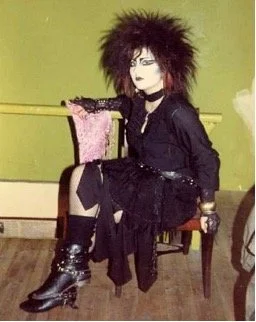Non-Conformity in the Goth Subculture
When you ask someone to think of ‘Goth’ it is likely they will imagine a sad looking, dressed in all black teenager with thick eyeliner. Goths are portrayed in the media as satanists, violent, or funny for how they look. However, as with most things, Goths are so different and so much more than that stereotype. A central theme of being Goth is non-conformity; going against society’s rules and being who you wanna be.
Image Courtesy of Forgotten Glory
Goth culture started in the 1970s, in London, but also in Manchester and Northern Yorkshire. It was born from the punk and post-punk movements. In 1979, British producer Martin Hannett described the Manchester post-punk band, Joy Division as ‘Gothic’ and this description led the term to be used for bands having moody and haunting themes. Some bands include: Bauhaus, Sisters of Mercy, The Cure, The March Violets, Siouxsie and the Banshees, and Depeche Mode. Goth is a music based subculture. Although it is music based that doesn’t make it not political. Like I stated, Goth was born from the punk movement making it inherently: anti-capitalist, anti-authoritarian, anti-bigotry, and anti-consumerism. The core values however are all about expressing yourself, nonviolence, freedom in sexuality and gender, and not being shackled by society’s expectations. When it comes to fashion, the main part is looking different and shocking. A big part of gothic literature and architecture is a mysterious and unsettling quality that Goths aims to give off through their fashion.
The identifiable traditional Goth style is dyed black hair, black or colourful eyeliner, a white foundation base, black lips. Wearing long black skirts and shirts, lot’s of velvet, corsets, chokers, top hats, and lace. Goth fashion can be seen as a mix Victorian mourning outfit with punk and modern influences. Lot’s of Goth icons of the 80s incorporated bats, skulls, blood and crosses, into their style and performances. A big part of gothic fashion is religious iconography. Mainly from Catholicism but also from pre-Christian and Pagan religions. Goth fashion sometimes also includes fetish wear like latex, studs, and fishnets. This is somewhat due to Gothic literature having a lot of sexual undertones. For example the relationships in Dracula and Carmilla have lots of yearning and themes about desire. From the 1980s to 2000s different types of Goth styles started: Cybergoth, Vampire goth, Victorian goth, White goth, Romantic goth and many more.
Romantic goth- reds and purples, lacy dresses, more whimsical, less edgy
Victorian goth- Traditional victorian styles, corsets, bustle skirts, parasols
Vampire goth- 18th century style clothing, lots of velvet, capes,
Cyber goth- Bright neon colours, PVC, Leather, vinyl, platforms, gas masks
You don’t have to stick to one style. You can dress cybergoth one day, then the next dress in basics. You can mix styles, or create your own, it is all about being yourself and rejecting society's standards. But you don’t have to dress Goth to be Goth and just because someone dresses Goth doesn’t mean they actually are. Being Goth is about the music and the beliefs. Goth fashion is for fun and rebellion. Some Goth icons to take inspo from are: Morticia- The Addams Family, Lydia Deetz- Beetlejuice, Elvira- Mistress of the Dark, Vampira- The Vampira Show, Nancy- The Craft, Tiffany- Bride of Chucky, and the Hex Girls- Scooby-Doo.
Image Courtesy of Thierry Mugler
As Goth became more mainstream, stores only selling Goth and alternative clothing began. Such as Demonia, and Lip Service which widened the spread of dressing the part of a ‘misfit’. Goth fashion in the 90s made its way into high fashion in the collections of Alexander McQueen, Christian Dior, Valentino, Mugler. Their collections used a moody and dark palette with vampiric inspirations. In the 90s people began experimenting with the Goth style but not listening to the music or being involved in the culture leading to the ‘mall goth’. This is because they were typically found hanging out in shopping malls, and having little knowledge of the subculture's values. The start of Hot Topic further led to the commercialisation of Goth style. It led to the Mall goth looking like a mix of grunge, punk, goth rather than more traditional Goth styles. A big part of being Goth is using the clothes you already have, thrifting and DIY-ing, however buying clothes from Hot Topic is not gonna make you a ‘poser’. It is all about not overconsuming and at first trying to make pieces yourself or buying sustainably.
Goth vs Gothic
Goth is Gothic but Gothic is not Goth. Goth is inspired by Gothic themes. People who dress with a Gothic style such as Whimsigothic, Southern Gothic, etc are not necessarily Goths. Southern Gothic is a semi-recent tik tok trend. It is inspired by the deep American South, Australian outback, the 1970s, and prairie clothes. Centred especially around Louisiana, Ethel Cain music, and Chrisitian iconography. The music associated with this style is a dark country mixed with blues and soul music. At the end of the day Goth and Gothic fashion is about rebellion. Using fashion, makeup, and hair to display the darker parts of society and culture. Goth is an expression of yourself and a way to reject the modern beauty standards.


